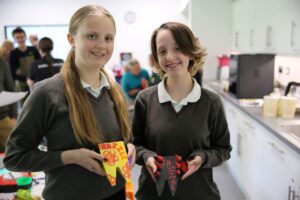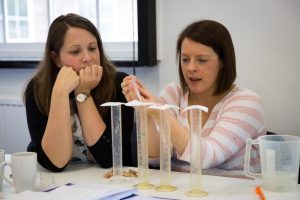Tara’s trip to Cheltenham Science Festival
Monday 8th June 2015
What fascinates us in imagining dinosaurs the size of hotels roaming through our cities or in having our own personal hover-boards and self-cleaning clothes? And do cult classics inspire science?
I began my journey through the jaws of a T-rex at Cheltenham Science Festival, 65 million years ago in DinoZone; a Jurassic hub, featuring a spectacular 7m skeleton of a Gorgosaurus. I spoke to scientists from Manchester University who were using X-ray experiments to find dilute traces of feather pigment in the fossils of dinosaurs. Understanding the colour of dinosaurs can help scientists review the role of plumage in courtship, reproduction and evolution.
I was so excited to see Jurassic Park’s very own technical advisor, Jack Horner. He spoke about the accuracy of the brand new Jurassic World film and if it will ever be possible to genetically modify a dinosaur like they do in the movie. I also caught up with renowned palaeontologist Pete Larson, famous for leading the team who excavated the world’s most complete fossilised T-rex ‘Sue’. I very quickly learned that there is a lot more to dinosaurs than digging up old bones.
My interests jumped from earth’s ancient history to technology of the future with a celebration of Back to the Future’s 30th anniversary. I watched a fanfiction panel discussion on Back to the Future Part 2. So many questions came up; what happens when you reach 88mph? What is gravity like in the future? What on earth is 1.21 gigawatts? And most interestingly, how does time travel affect causality? I was disappointed to face the reality that we have no proof of ever succeeding in time travel. Well, have you ever met anyone from the future?
Flying cars have never taken off and we’ve yet to power our lives with Mr Fusion but some technologies have been spot on. We do have our own personal communication devices and technology is becoming ever more wearable; plasma TV screens and Skype are now a standard part of our lives. Have these technologies been inspired by the cult classic?
I was intrigued to hear how the panel’s chair, geneticist and broadcaster Adam Rutherford was inspired to study science after watching Back to the Future and I wouldn’t be surprised if Jurassic Park also bred a generation of passionate palaeontologists. Everyone remembers the first time they’ve watched Jurassic Park and perhaps made a quick wardrobe change after seeing Back to the Future. As a science communicator, it’s really exciting to see how our personalised connection to these classics can cultivate curiosity and a future generation of inspired scientists. Not only can pop culture inspire future scientists but it can also show to the entire world, the creative role imagination plays in science.
I really enjoyed by trip Cheltenham Science Festival 2015 and I thoroughly recommend it to people who are interested in seeing the variety of ways science is communicated to families, adults and movie fans alike.





